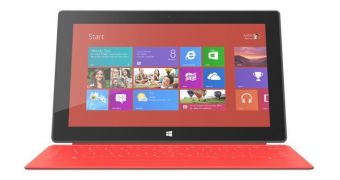Windows 8 has often been referred to as the new Vista, but it appears that another platform that got to see daylight in the last couple of years could become the successor of what has been called the biggest fail in Microsoft's history.
Windows RT, the Windows 8 version that was specifically created for ARM-based tablets, including Microsoft's very own Surface models, could get the axe in the coming months, not necessarily due to slow sales, but because Microsoft has finally understood that users are more interested in the full version of Windows 8.
Back in October 2012, Microsoft presented the Surface RT, its first tablet that came with Windows RT, explaining that it had everything that you couldn’t find on an iPad, including powerful multi-tasking features (which, by the way, are rumored to debut on Apple tablets in iOS 8).
The Surface RT was running Windows RT, which, despite the fact that it looked just like Windows 8, only allowed users to install apps from the store. Support for x86 and x64 apps was missing and there's no doubt that many decided to give up on the idea of buying a Surface RT just because of this.
Redmond tried to tackle this issue by putting the focus on Windows Store apps designed to run in the controversial Metro environment, which actually really makes a sense on a tablet. The number of apps available in the store however remained a major drawback, and although a number of large software companies decided to port their apps to Windows RT, others simply preferred to stay away.
Microsoft continued investments in Windows RT, so new updates arrived on tablets running it. Both Windows RT 8.1 and Windows RT 8.1 Update are now available for these devices, and word is that a second update specifically designed for Windows 8.1 will also be launched on RT.
But Microsoft has recently made a decision that could actually be living proof that Windows RT isn't exactly the product the company wants to continue investing in. Reports coming from sources very close to Microsoft's development plans indicated that Redmond decided at the last minute to cancel the Surface Mini, an 8-inch tablet running Windows RT, and launch the new Surface Pro 3 instead.
The Surface Pro 3 is powered by the full version of Windows 8.1 and comes with state-of-the-art hardware, but also with a hefty price tag of approximately $2,000 (1,500 euro) for the top-of-the-range model.
The Surface Mini was reportedly Microsoft's first attempt at the small tablet market, coming with an 8-inch screen, Windows RT 8.1 Update, and a digital pen supposed to make note taking fast and simple. But the new CEO Satya Nadella and the head of the devices division, former Nokia CEO Stephen Elop, tried out the tablet and decided to cancel the project.
Was it because of the tablet or because of Windows RT? Hard to say, but the end result was clearly below expectations, so the two Microsoft executives decided to pull the plug on this device. What's more, it appears that Microsoft has already manufactured nearly 20,000 tablets, so they're all sitting somewhere in a warehouse, as the company might at some point have a change of heart and decide to bring them to the market.
While we don’t know for sure whether Windows RT was the reason why Microsoft decided to discontinue the Surface Mini, both the Surface RT and the Surface 2 have experienced more or less poor sales. The Surface RT itself caused a $900,000 (680,000 euro) loss to Microsoft, while the Surface 2, even though it's selling a little bit better, is still far from being on profit.
A recent filing with the United States Securities and Exchange Commission revealed that Microsoft reported revenues of $494 million (362 million euro) from the Surface division in the first quarter of the year, while the cost of revenue reached $539 million (395 million euro). This means that Microsoft is still losing money with every Surface it sells, and the RT models are clearly responsible for this.
Surface RT models seem to be pretty great devices, although LTE connectivity should be available on all versions, but Windows RT is definitely pushing potential buyers back to other devices. The Windows Store has grown a lot lately, and there are more than 160,000 apps available for download right now, but customers still need support for traditional desktop software, which is obviously impossible on an ARM tablet that's specifically designed for longer battery life.
The best-selling Surface model would clearly be a mix of the RT and the Pro models, powered by the full version of Windows 8, coming with Office and featuring long battery life to make sure that everyone can use it on the go without being afraid of running out of power.
This could take a while until it's being developed, but in the meantime, Windows RT continues to scare away buyers who do not want to spend more money for a Pro model, going instead for an iPad or Android tablet.

 14 DAY TRIAL //
14 DAY TRIAL //